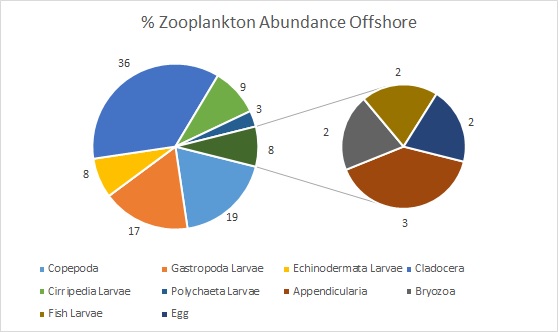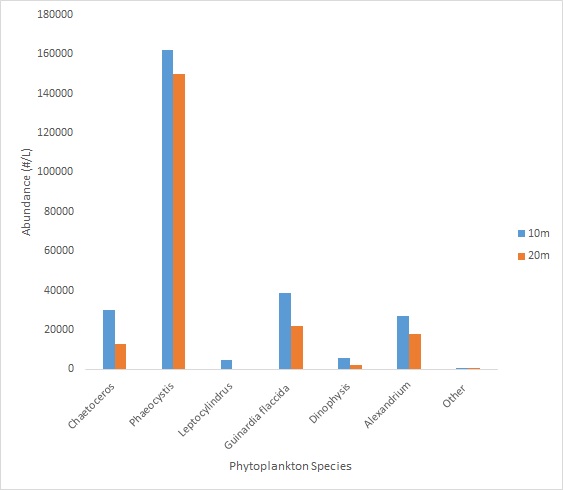 back to top
back to top
Disclaimer: The views and opinions expressed are solely representative of the contributors, and are not necessarily condoned or supported by the University of Southampton and/or the National Oceanography Centre Southampton.

Figure 9: Pie charts representing the total zooplankton abundance measured at the offshore sampling site.
Zooplankton
Phytoplankton

Figure 8: Total phytoplankton abundance at the offshore sampling station.
The English Channel is characterised by sensitivity to climate variability. Water temperature, light, nutrient availability and vertical stratification are all factors affecting phytoplankton abundance. The expectation would be a high concentration of diatoms as there is a bloom in late spring, early summer time (Widdecombe, et al., 2010). Over the summer period, the freshwater input to the Fal will cause variability in the flux of nitrate and phosphate (Lewis & Allen, 2009). The flux of freshwater from the rivers will affect the abundance of phytoplankton species and effect the dominant species in relation to nutrients. However, offshore, the freshwater input will have a minimal effect on the phytoplankton abundance.
The CTD was deployed at hourly intervals, with samples taken at the surface and intermediate depths.
Carrick Roads time lapse
In the time lapse series there is variation in the abundance of each species. This
is due to the change of the tide. There is a clear dominance of diatoms which corresponds
with the annual trend of spring and summer dominance (Widdecombe, et al., 2010).
The two most abundant species are Alexandrium minutum and Chaetoceros spp. The high
numbers of A. minutum found is of interest as one of the largest problems in the
Fal is the accumulation of saxotoxin (SXT) from coastal blooms of A. minutum, this
can lead to Paralytic Shellfish Poisoning (Perez-
Through the time lapse series the species abundances changes, over the first 3 hours there appears to be a higher abundance of phytoplankton at the surface compared to the intermediate depth. The tide was ebbing at these stages. At low tide, 13:55 UTC, there is a higher number of phytoplankton at intermediate depths compared to the surface (figure 5). This may be because of the slack tide and less water movement in the lower water layers. When the tide is in flood the surface again appears to have more phytoplankton than the intermediate depths.
With the processing of the data there is element of human error as identifying the different species can be subjective. This should also be taken into consideration when looking at the variation of species.
Offshore
Offshore, Phaeocystis spp. was the dominant genus. The dominant species were very similar at both 10m and 20m, however; the numbers were consistently greater at 10m (figure 8). This could be due to the increased light at the surface, resulting in greater productivity at the surface. However; this is unusual as the stratified structure of the vertical water column should have a greater effect on phytoplankton. In the summer months there is a deep penetration of light in the water column (Townsend et al 1992), this means that phytoplankton are able to photosynthesise at a lower depth. Hence, the phytoplankton abundance should be highest at lower depths where there is sufficient nutrients and light, the nutricline. These results are possibly due to subjective identification by all contributors; some of the debris from 10m may have been perceived as cells.
Data was collected every hour over a period of 6 hours around the location: 500 09.961N, 0050 02.354W. Zooplankton abundances were observed and tabulated. The data is displayed in Figure 1.
In another study, variability in the vertical distribution of weak swimmers decreased dramatically with increasing turbidity (Maar, 2003). However, the variability in the vertical distribution of copepods is independent of turbidity as they are strong swimmers. The Fal Estuary is a tidal dominated estuary and therefore the water is very vertically turbulent. This means that copepods should be abundant.
Data was collected using a 200 µm mesh size zooplankton net. The data was collected every hour over 6 hours from 10:20 UTC until 16:03 UTC. Samples were then examined under the microscope and species were identified and counted for each different time (Maar, 2003).
Findings
The most abundant species are polychaete larvae (figure 9). These are robust and widespread, living in a variety of conditions, explaining why they are able to survive in the turbulent well mixed water of the Fal Estuary. The next most abundant species are copepods. These organisms are able to survive in this environment because they are strong swimmers within the viscous sublayers in which they live. Gastropod and Echinoderm larvae are also abundant in these samples due to these organisms being widespread and able to survive in the conditions of the estuary. The total abundance of the zooplankton changes throughout the time lapse due to the change in the tide; however copepods remain consistently abundant at each station. In a few samples the polycheate larvae was significantly dominating, the copepods were slightly less in concentration but consistently dominant across all samples.
References
Lewis, K. & Allen, J., 2009. Validation of a hydrodynamic-
Maar, M. 2003. Distributions of zooplankton in relation to biological-
Perez-
Townsend, D, Keller, M., Sieracki, M., Ackleson, S. 1992. Spring Phytoplankton blooms in the absence of vertical column stratification. Nature. 360(1). pp59.
Widdecombe, C. et al., 2010. Long-